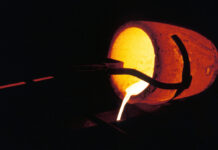
THE return to favour of South Africa’s gold sector among investors was effectively rubber-stamped today as both Sibanye Gold and Gold Fields took their place in the Johannesburg Stock Exchange’s Top 40 Index, a development that will see the counter’s attract tracker fund and other investors who follow the index.
Sibanye Gold spokesman, James Wellsted, confirmed the company would take up 34th place in the Top 40 based on the semi-annual assessment of the average value of the firm’s free-float shares. It was earlier described by the company as “… a significant milestone” following its 2012 listing.
It will be joined by Gold Fields, the company which demerged assets to create Sibanye. Gold Fields will take 25th place in the standings. AngloGold Ashanti was re-admitted to the Top 40 in the first half of 2016.
That means that excluding Sasol, the petrochemicals company that is one of South Africa’s largest coal miners, some seven mining stocks are in the Top 40 Index, comprising about 18% all companies counted there. Anglo Platinum is excluded from the Top 40 – not unsurprising as only 20% of the firm’s shares are in free-float.
Johannesburg’s gold mining index has nearly tripled in value after falling to its lowest level in 14 years just over a year ago when it fell to 810 points. The gold index is currently at 2,421 points after hitting 2,906 points on August 4, its highest level since February 2012.
Said Neal Froneman, CEO of Sibanye: “Considering the relatively short history since the group listed in February 2013 with a market capitalisation of less than R10bn, to now be recognised as one of the 40 largest companies listed on the JSE is something I am extremely proud of and highlights the significant returns Sibanye has delivered to shareholders”.
Shareholders in Sibanye had received total returns from share price appreciation and dividends of over 350% in the last three-and-a-half years, a compound growth rate of over 50% a year, the company said.
Goldman Sachs said in mid-August there was still potential for gold shares to improve. “For gold equities we believe there is still significant upside (on spot) as they are pricing in about 10% lower gold prices versus spot – which we believe is fair given the lack of confidence in the gold price outlook,” it said.
The next catalyst for gold equities would come with the reporting of the 2016 financial year-ends when announcements would be made regarding capital allocation either through capital expenditure or the resumption of dividends or dividend ramp ups, it said.











